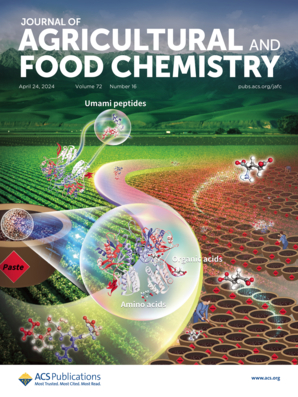Engineering Corynebacterium glutamicum for the Production of 5-Aminolevulinic Acid under Microaerobic Conditions Guided by a Genome-Scale Metabolic Network.
IF 5.7
1区 农林科学
Q1 AGRICULTURE, MULTIDISCIPLINARY
引用次数: 0
Abstract
5-Aminolevulinic acid (5-ALA) has been widely used in modern agriculture and therapy as a biostimulant, feed nutrient, and photodynamic drug. Although metabolic engineering strategies have been employed to increase the yield of 5-ALA in Corynebacterium glutamicum, the production of 5-ALA under microaerobic conditions has not been studied. In this paper, we developed, for the first time, overproducing-5-ALA Corynebacterium glutamicum strains under microaerobic conditions, guided by a genome-scale metabolic network model. The engineered strain for the C4 pathway synthesis of 5-ALA was constructed based on the Corynebacterium glutamicum genome-scale metabolic network model iCW773 under different oxygen environmental conditions. The fusion of the key enzymes SucCD and HemA effectively opened the substrate channel and improved the biosynthesis of 5-ALA. Further selection of 5-ALA synthetases alleviated the inhibitory effect of heme, which further improved the titer of 5-ALA. Combinatorial optimization of the lpd, coaA, and ppc genes was employed to enhance the supply of the precursor succinyl-CoA. Finally, a 3.8 g/L 5-ALA titer was achieved in a 5-L bioreactor at 8% dissolved oxygen. This study provides a reference for the synthesis of 5-ALA or other high value-added chemicals with succinyl-CoA as the precursor under microaerobic conditions.在基因组尺度代谢网络引导下,谷氨酸棒状杆菌微氧条件下生产5-氨基乙酰丙酸的工程研究
5-氨基乙酰丙酸(5-ALA)作为一种生物兴奋剂、饲料营养物质和光动力药物在现代农业和治疗中得到了广泛的应用。虽然代谢工程策略已被用于提高谷氨酸棒状杆菌5-ALA的产量,但在微氧条件下5-ALA的产量尚未研究。在本文中,我们首次在基因组尺度代谢网络模型的指导下,在微氧条件下开发了过量生产5- ala的谷氨酸棒状杆菌菌株。以谷氨棒状杆菌基因组尺度代谢网络模型iCW773为基础,构建了不同氧环境条件下C4途径合成5-ALA的工程菌株。关键酶SucCD和HemA的融合有效地打开了底物通道,促进了5-ALA的生物合成。进一步选择5-ALA合成酶可减轻血红素的抑制作用,从而进一步提高5-ALA的效价。通过对lpd、coaA和ppc基因的组合优化,提高了前体琥珀酰辅酶a的供给。最后,在溶解氧为8%的5-L生物反应器中获得3.8 g/L的5-ALA滴度。本研究为在微氧条件下以琥珀酰辅酶a为前体合成5-ALA或其他高附加值化学品提供了参考。
本文章由计算机程序翻译,如有差异,请以英文原文为准。
求助全文
约1分钟内获得全文
求助全文
来源期刊
CiteScore
9.90
自引率
8.20%
发文量
1375
审稿时长
2.3 months
期刊介绍:
The Journal of Agricultural and Food Chemistry publishes high-quality, cutting edge original research representing complete studies and research advances dealing with the chemistry and biochemistry of agriculture and food. The Journal also encourages papers with chemistry and/or biochemistry as a major component combined with biological/sensory/nutritional/toxicological evaluation related to agriculture and/or food.

 求助内容:
求助内容: 应助结果提醒方式:
应助结果提醒方式:


